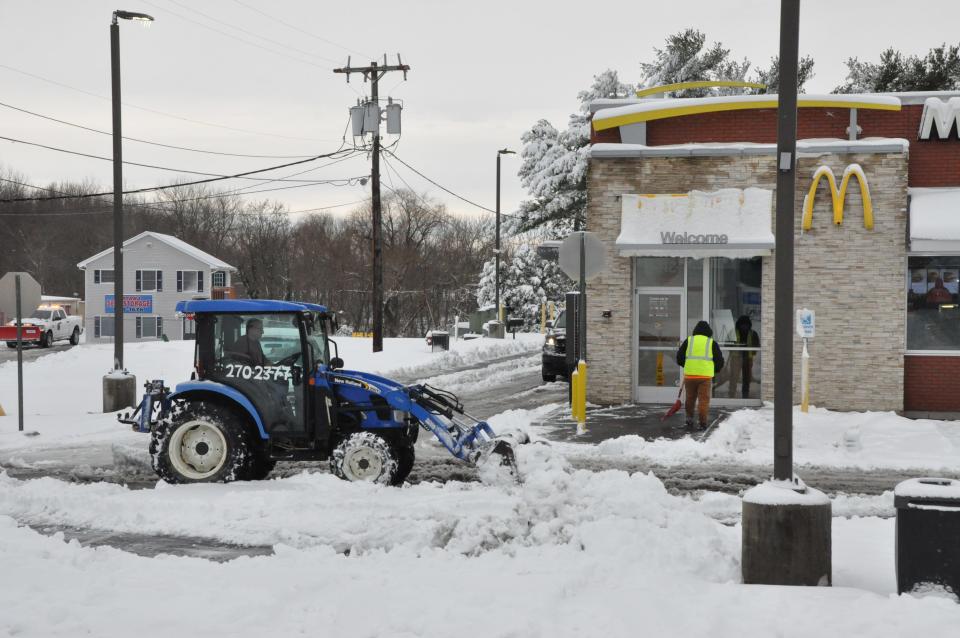How much snow will Delaware get this winter according to the oldest almanac
Democrats vs. Republicans, Coke vs. Pepsi, Eagles vs. Cowboys: These are some of the rivalries that fuel great debates. But what about the weather forecasting rivalry between almanacs?
Last month Delaware Online/The News Journal published a story about the winter predictions from the Farmers’ Almanac.
Now the Old Farmer’s Almanac, which bills itself as “the original farmer’s almanac,” has weighed in with its forecast.
“We’ve been weather predicting since 1792 when George Washington was president,” the company boasts on its website.
The Old Farmer’s Almanac is led by Carol Connare, the publication's 14th editor and the second woman to hold the title.
What’s the forecast for Delaware?
The forecast for the Atlantic corridor is for above-normal winter precipitation and snowfall, 2 to 3 inches above monthly averages.
The Old Farmer’s Almanac groups Delaware in the Atlantic corridor with eastern Virginia and Maryland, southeastern Pennsylvania, most of New Jersey, a bit of southeastern New York, most of Connecticut, all of Rhode Island and southeastern Massachusetts. Cities in this corridor include Richmond, Virginia; Washington; Baltimore; Wilmington; Philadelphia; Atlantic City; New York; Hartford, Connecticut; Providence, Rhode Island; and Boston.
“The snowiest periods will occur at the end of December, late January and mid-February,” according to the almanac.
However, winter temperatures will be above normal overall in the corridor.
“Specifically, December is slightly above average temps. Temperatures for January and February are below average. The coldest spell will run from late January into mid-February,” the almanac said.
More specific forecasts by area and date are available in the almanac.
Another farming-related story: Apples, pumpkins and trees: our guide to u-pick offerings in Delaware this fall, winter
What methods does the almanac use to predict the weather?
The Old Farmer’s Almanac uses three main scientific methods to make long-range predictions:
Solar science, the study of sunspots and other solar activity.
Climatology, the study of prevailing weather patterns.
Meteorology, the study of the atmosphere.
“We predict weather trends and events by comparing solar patterns and historical weather conditions with current solar activity,” the almanac said. “Our forecasts emphasize temperature and precipitation deviations from averages, or normals. These are based on 30-year statistical averages prepared by government meteorological agencies.”
Comparing the almanacs
Competitor Farmers’ Almanac, which dates back to 1818, gave a similar winter forecast: "For those of you living along the I-95 corridor from Washington to Boston, who saw a lack of wintry precipitation last winter, you should experience quite the opposite, with lots of rain/sleet and snowstorms to contend with."

Farmers’ Almanac predicts that storms could affect the East Coast several times this winter:
"The second week of January will be stormy, snowy, and wet for both the Pacific Coast and the Eastern States."
"An East Coast storm affecting the Northeast and New England states will bring snowfall, cold rain and then frigid temperatures, during the second week of February."
"Another East Coast storm will bring a wintry mess to this area during the first week of March."
The Farmers’ Almanac uses a secret mathematical and astronomical formula to predict long-range weather trends, taking sunspot activity, tidal action, the position of the planet and many other factors into consideration.
More about the competing almanac: Farmers' Almanac says don't expect another mild winter in Delaware. See its forecast
How accurate are the forecasts?
“Longtime fans … who follow our weather predictions claim they are accurate approximately 80% to 85% of the time,” according to the website for the Farmers' Almanac.
The website for the Old Farmer’s Almanac said, “Our results are often very close to our traditional claim of 80%.”
The University of Illinois has studied the forecasts and said the accuracy of such long-range predictions is closer to a coin toss.
Professor emeritus John Walsh in the university’s department of atmospheric sciences examined forecasts of monthly temperatures and precipitation of the Old Farmer’s Almanac by comparing them with the actual weather data over a five-year period.
“Results of this study found that 51.9% of the monthly precipitation forecasts and 50.7% of the monthly temperature forecasts were accurate, concluding that these percentages are similar to the 50% success rate expected by chance,” according to the University of Illinois extension service website.
Almanacs also feature tips for home and garden, history, humor
While the weather forecasts grab the most attention, almanacs offer an abundance of homespun advice, time-tested tips and interesting stories.
The 2024 Old Farmer’s Almanac features reports about gardening trends including scratch-and-sniff plants and the continued push for no-lawn landscapes, recipes, history, fishing advice, humor and natural cures for colds, aches and pains.
The company said, “After you come in from the cold, you’ll find The Old Farmer’s Almanac perfect for cozying up with plenty that’s ‘useful, with a pleasant degree of humor,’” the saying featured on the almanac’s cover.
That iconic yellow cover includes a hole in the top left corner so the book can be hung on a hook in the kitchen, garage or workshop.
The publication is now available for $8.99 where books and magazines are sold and on the almanac's website.
Reach reporter Ben Mace at rmace@gannett.com.
This article originally appeared on Delaware News Journal: Old Farmer's Almanac announces winter weather forecast for Delaware

